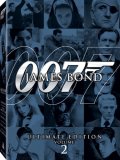| Reviews & Columns |
|
Reviews DVD TV on DVD Blu-ray 4K UHD International DVDs In Theaters Reviews by Studio Video Games Features Collector Series DVDs Easter Egg Database Interviews DVD Talk Radio Feature Articles Columns Anime Talk DVD Savant Horror DVDs The M.O.D. Squad Art House HD Talk Silent DVD
|
DVD Talk Forum |
|
|
| Resources |
|
DVD Price Search Customer Service #'s RCE Info Links |
|
Columns
|
|
|
James Bond Ultimate Edition Volume 2
MGM and 20th Century Fox have gone to the well again, for another series of boxed Bond DVD sets, this time entitled the James Bond Ultimate Editions, and indeed they are - until the studios decide to do it again in the next couple of years. The main selling points for these new Ultimate Edition volumes are the complete frame-by-frame digital restorations of all 20 Bond films, performed by Lowry Digital Images, and they are spectacular. Particularly noticeable in the older titles (such as Thunderball, included in this volume), the Lowry restorations return the films to shimmering, sparkling clarity, with a wealth of fine detail restored to the images. As well, these new Ultimate Editions provide all-new DTS 5.1 Surround Audio soundtracks, giving the viewer a massive, speaker-blowing wall of sound. And finally, the James Bond Ultimate Editions gather together a mind-boggling assemblage of DVD extras about all things Bond, including new documentaries and commentaries, as well as previously released material, all packaged in an attractive box set. Even if you're like me, and you've bought umpteen video, laserdisc, and DVD versions of the Bond films, it's impossible to say no to these incredible Bond box sets.
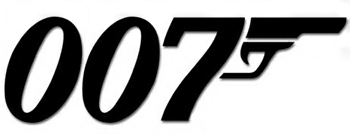
Of course, Bond wasn't born at the movie theatres; in the 1950s, he was the star of several spy meller/potboiler novels by former British Intelligence officer, Ian Fleming. Borrowing heavily from author Mickey Spillane's Mike Hammer novels, Fleming took Hammer's obsession with sex and sickening violence (as well as his total disregard for social norms) and molded it into the more socially accepted world of international espionage. These essentially sadomasochistic male fantasies were given a certain dash of class by having the hero educated at Eton, becoming a commander in the British Navy, and during his evolution into a secret agent, acquiring an almost encyclopedic knowledge of the finer things in life, including wine, women, gambling, and guns. It didn't hurt sales (which were already strong) when President Kennedy announced that the Bond thrillers were some of his favorite light reads. Plans were drawn up to star Bond in a television series (it fell through, but an early TV version of Casino Royale was filmed with Barry Nelson as the first Bond) and movies (interestingly, Fleming initially wanted James Stewart (!) as Bond). In 1962, Dr. No, the first Bond movie, premiered, and was a surprise smash success with audiences around the world.
Dr. No certainly didn't introduce graphic violence to the screen (a case could be made that Hitchcock's Psycho heralded in the notion of modern screen violence), nor, obviously, sex. What Dr. No did initiate for movie audiences was the notion of a character totally outside the bounds of mainstream society. We're not talking about the traditional Hollywood loner, or thief, or the relatively new movie icon, the anti-hero. James Bond had a license to kill anyone. He was authorized by his government to take out anyone who stood in the way of his mission - with absolutely no social or legal repercussions. American audiences had endured decades of the moral quid pro quo of the Production Code, where various sins committed by characters were met with corresponding punishments, to even out the perceived crimes against God and society. If you murdered someone, you usually wound up dead at the end of the film. If you slept with someone out of wedlock, you usually wound up dead at the end of the film, and so on. But Bond suffered no such fate. He killed with impunity, and he wasn't punished for it. He slept with various women - and he enjoyed it - and he didn't have to apologize for it, nor pay for it, at the end of the film. No better distillation of Bond's amoral credo has been written than in the lyrics to Thunderball's theme song:
He always runs while others walk.
He acts while other men just talk.
He looks at this world, and wants it all,
So he strikes, like thunderball
He knows the meaning of success.
His needs are more, so he gives less.
They call him the winner who takes all,
And he strikes, like thunderball.
Any woman he wants, he'll get.
He will break any heart without regret.
His days of asking are all gone.
His fight goes on and on and on.
But he thinks that the fight is worth it all,
So he strikes like thunderball
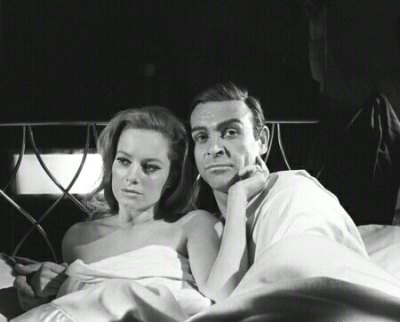
Adding to this powerful, subversive moral outlook was the additional allure of consumerism run amok. Although a powerful force from the start of the Industrial Revolution, after the Second World War, rampant consumerism came to dominate the American society, and by osmosis, began to influence the rest of the world, as well. The world wanted things, bright, shiny new things, and James Bond proved to be the master of this voracious appetite. While he may have not had a brand new kitchen in his split-level in the suburbs, what he did have was of the very best quality: exquisitely tailored Saville Row suits, the finest sports cars, the most expensive drinks and food, as well as deadly, high-tech gadgets that made that Space Commander TV remote control you coveted, look like the most primitive caveman tool. What average slob out there, going to the movies in his beat-up Plymouth, didn't sob inwardly when Bond revved up his beautiful, deadly Astin Martin? As well, Bond's adventures took him all over the world - a world still too costly and remote for most audiences to visit. Think your trip to Carlsbad Caverns with the kids was fun? Try Miami Beach -- alone -- with a gorgeous girl giving you a massage. And when did Bond ever pay for any of this? While you fumbled in your wallet to come up with parking money for Disneyland, Bond sauntered through the lobby of a fabulous hotel, right past the front desk - in a perfectly cut tux. The notion of Bond as the ultimate consumer - consumer of material goods, consumer of women - held a powerful appeal for post-war audiences.
The political climate of the times also fueled the Bond phenomenon. The Cold War was at its height, and people seriously considered, on a regular basis, whether or not they were going to die in a nuclear holocaust that day. Nihilism was creeping into the American psyche, and what better purveyor of that credo than James Bond. Sure, there were occasional sops to "King and Country," but anyone watching the films knew that Bond was out for himself - out to have a good time, out to match his powers against the various megalomaniacs that threatened the world. It's no coincidence that many of the plots revolved around the use of, or the threat of nuclear weapons; if you have the ultimate superhero, he needs to be threatened by the ultimate weapon.
And of course, don't forget the sex. Much has been written about Bond as the ultimate adolescent male fantasy figure, who bedded only the best looking women - and then had the confidence to drop them! The notion of the male "swinger" may have gotten its start with Hugh Hefner and Frank Sinatra's Rat Pack, but Bond drove the point home with males all over the world - here was concrete proof that a tux and an Astin Martin could get you babes. How many dopey guys ordered Vodka martinis, shaken not stirred, in crummy bars all over the world, hoping someone would notice? The "spy-as-swinger/heel" became a cliche almost as quickly as it permeated the pop culture lexicon. But don't underestimate the power that Bond had to ensnare female audience members, as well. Certainly, much of the credit for that has to go to Sean Connery. Although he had been knocking around for a while in the movies (even appearing in a Disney film), he was a relative new face to audiences in 1962 - the perfect stranger that could star in the female audiences' fantasies. Couple that with his obvious personal magnetism and his cold, unemotional portrayal of Bond, and you have the perfect ingredients for exactly the kind of man every woman in the world should avoid like the plague. Bond wasn't just a man of action that every male audience member wished he could be; he was also the dangerous, unattainable fantasy lover that many women in the audience secretly desired -- at least for a few hours in a darkened cinema theatre.
After the success of Dr. No, From Russia with Love (1963) and Goldfinger (1964) followed, each making more than the last (a rarity in the movies). Goldfinger really started the Bondmania ball rolling, with B.O. records broken all over the world. By 1965, the first two Bonds had been re-released as a double feature (again, with boffo box office), and the world was going crazy for the next Bond film, Thunderball.
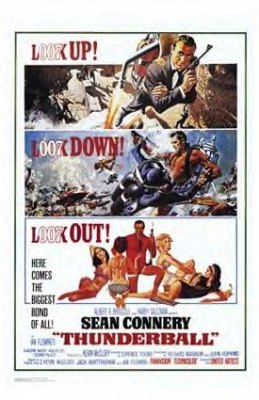
THUNDERBALL
1965 / 125 minutes
Starring: Sean Connery, Claudine Auger, Adolfo Celi, Luciana Paluzzi
Director: Terence Young
Screenplay: Jack Whittingham, Richard Maibaum, John Hopkins
Cinematographer: Ted Moore
Music: John Barry
Editor: Ernest Hosler
Art Direction: Ken Adam
Theme Song: Tom Jones
Producer: Kevin McClory
Ernst Stravro Blofeld, the head of SPECTRE (Special Executive for Counter-intelligence, Terrorism, Revenge and Extortion) and James Bond's arch enemy, has devised a plan to hijack two NATO nuclear bombs, with the hopes of blackmailing the world. His intended target? Miami, Florida. Emilio Largo (Adolfo Celi), Number 2 in the SPECTRE organization, is coordinating the operation, with the aid of Count Lippe (Guy Doleman), Fiona Volpe (Lucianna Paluzzi), Vargas (Philipe Locke), and Angelo Palazzi (Paul Stassino). Largo's plan is to substitute NATO pilot Major Derval (Stassino) with substitute Palazzi. Palazzi will down the NATO plane carrying the nuclear bombs in the Bahamas, and Largo and his henchman will transfer the bombs to his high-tech yacht, the Disco Volante.
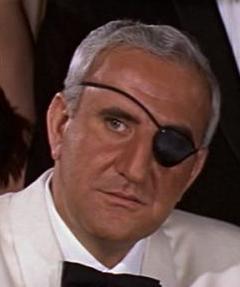
James Bond (Sean Connery), originally assigned to the Canadian sector for "Operation Thunderball," convinces M (Bernard Lee) that after discovering a connection between Derval and Count Lippe at the sanitarium Bond was staying at, he would be better used down in the Bahamas, where Derval's sister, Domino (Claudine Auger) is staying. It just so happens that Domino is also the ward/mistress of Largo. Bond quickly hooks up with American CIA agent and friend Felix Leiter (Rik Van Nutter) to find out what's going on with Largo's mysterious yacht. As well, Bond seduces Domino to get a better idea of what Largo is up to. A climatic underwater battle between Bond and the U.S. Navy versus Largo and his henchman, will decide the outcome of SPECTRE's plans. Will Bond save the world from international nuclear blackmail?
James Bond would reach his apex of popularity in 1965 with Thunderball. If you adjust the numbers for inflation, Thunderball is still the biggest money-making Bond film of all time - no mean feat considering that was over 40 years ago. The world in 1965 was going absolutely insane waiting for this installment in the Bond saga, fueled not only by the success of the previous films, but also by the unprecedented merchandising of all things Bond. Everything from raincoats to cologne to toys to shoes were tied in with Bond, and the public couldn't get enough of it. Certainly this promotional campaign, and its subsequent stunning success, was the blueprint for all future movie promotional schemes; the world wouldn't see its like again until the Star Wars phenomenon in 1977.
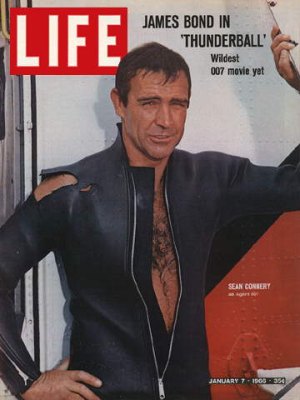
Although Kevin McClory is credited as the producer of Thunderball (due to a complicated legal battle involving Fleming and an unsuccessful movie deal with McClory), the real string pullers behind the Bond franchise were Albert Broccoli and Harry Saltzman - the original Bond producers who shaped and guided the series. They knew that to keep audience interest, Thunderball would have to be bigger and better than the previous three films. Now, Thunderball would be filmed in the massive Panavision widescreen format (the others were filmed in the standard 1.66 Academy ratio). Pinewood Studio backlots in England wouldn't do for the sweep and scope of Thunderball; now Bond would go to the color-drenched Bahamas. And as desirable as Pussy Galore (Honor Blackman) was in Goldfinger, Bond would be supplied with no less than four beautiful young women here. Of course, attention had to be paid to the gadgets, too, so the Astin Martin from Goldfinger was now equipped with an optional jet pack in the boot. Bond couldn't just swim around underwater with a regular scuba tank; his is self-propelled, with powerful jet-propelled spear guns. Everything in Thunderball is bigger, more expensive, more deadly, more sexy; it's designed to overwhelm the viewer with sensual largesse.
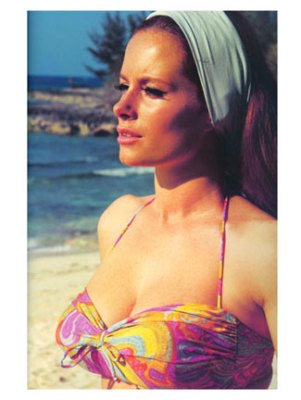
But is it better? Well...yes, it is, just by sheer size alone. There's a scope to Thunderball that's impressive, from the panoramic visuals, to the outsized, opulent sets. Connery is also better, more confident as Bond, than in his previous three outings. Publically, he was already quoted as saying he was tired of Bond, but he looks fit and tanned here, easily fitting into the character's skin, while delivering a double entendre better than anyone in the movies at the time. Celi as the villain is appropriately menacing and vicious, while still staying believable, and his henchmen are memorable - most notably the luscious red-headed Paluzzi as Fiona, Bond's most delectable foe. There are problems with Thunderball, most notably its length. After several scenes of Bond underwater, with John Barry's uncharacteristically monotonous music playing, it can get to be a little much. The final fight scene, as everyone has already noted, had continuity problems (blue mask, black mask, blue mask on Bond), and after a protracted, slow-paced middle section, there's a general air of just too much of everything. Perhaps the producers should have tried harder to get their original choice for director, Goldfinger's Guy Hamilton, instead of relying on Terence Young. Young is credited for really refining and molding the rough and tumble Connery into the part of suave James Bond, but Young's style is a little too stately and calm for such a long, heavy picture; Hamilton might have brought a little more speed, a little more lightness to the proceedings. Still, Thunderball accomplishes what it sets out to do: top the last Bond picture. And you can't ask for more than that in a Bond film.
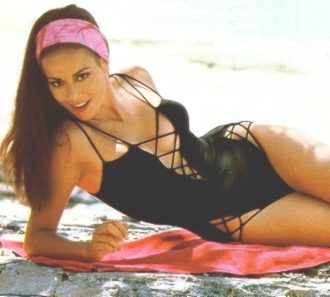
The DVD:
The Video:
The Lowry frame-by-frame digital restoration of Thunderball is nothing short of astonishing. Since this is the oldest title in this particular volume of the James Bond Ultimate Editions, I was most curious to see how the restoration was handled. I've owned various copies of Thunderball on video and disc, and this is clearly a giant improvement over those previous transfers. There's a wealth of fine detail in the image now that makes the film pop off the screen. Subtle shadings of color now come through in some of the island scenes that I've never seen before in any transfer. As well, most of the special effects shots now look realistic -- particularly the jet pack scene in the opening pre-credit gambit.The Audio:
The newly offered DTS Surround soundtrack is phenomenal (a Dolby 5.1 Surround is offered as well). Be careful when you start the film; the blast from Leo the Lion's roar almost blew out my speakers. And when Tom Jones belts out the quintessential Bond theme, it's an amazing aural experience. Clearly, the people behind the restoration of these Bond films knew exactly what they were doing, and what needed to be done to get the fans to buy these titles one more time.The Extras:
The James Bond Ultimate Edition: Volume 2 disc set contains a sensory-overload of extra material for each film; it's rather overwhelming. First, there are two separate audio commentaries for each film. The first commentary track for Thunderball, on disc one, is hosted by author John Cork (The James Bond Legacy: 40 Years of 007 Movies), and includes new and old audio clips from director Terence Young; Ricou Browning, the director of underwater sequences; production designer Ken Adam; special effects coordinator John Stears; composer John Barry, stars Lucianna Paluzzi, Molly Peters, Martine Beswick, Rose Alba, and quite a few more guest speakers. The second audio commentary features Cork speaking with editor Peter Hunt, as well as commentary from screenwriter John Hopkins. As well, there are surprise bonuses such as including Dianne Warwick's original theme song, Mr. Kiss Kiss Bang Bang played over the credit sequence. These commentaries are invaluable gold mines of information for even the most hard-core Bond fan, and I learned quite a lot from them.Disc two of Thunderball is devoted entirely to special features. The main menu is divided into the same sections for each film. For Thunderball, under the Declassified MI6 Vault section, there's a fascinating, perceptive NBC documentary from 1965 entitled, The Incredible World of James Bond. Next, there's another vintage documentary from Ford Motor Company called A Child's Guide to Blowing Up a Motor Car, which ends on a decidedly English black humor note. Next is a collection of home movies taken by production designer Ken Adam; he also narrates and gives context for the amazing footage. Next, there's an interview, with vintage footage, of Bill Suitor: The Rocket Man Movies, about the gentleman who flew the jet pack in the film. Then, we have the Thunderball Boat Show Reel which shows an alternate cut of the final underwater battle. Finally, we have Selling Bonds - Original 1965 Television Commercials that feature some product tie-ins with the movie. In the 007 Mission Control section menu, there are several individual menus that allow you to see your favorite moments from the film instantly. They include: 007, Women, Allies, Villains, Mission Combat Manual, Q Branch, and Exotic Locations. It's a great way to just skip to a cool part of the movie, without navigating the larger scene selection menu. In the Mission Dossier section menu, there are three documentaries narrated by actor Patrick Macnee: The Making of Thunderball, The Thunderball Phenomenon, and The Secret History of Thunderball. All are from 1995, and have been previously released on video and disc. The image quality of these are fairly poor, next to the other supplemental material. In the Ministry of Propaganda section menu, there are separate menus for a wealth of vintage trailers from both theatres and television, as well as some radio spots advertising the film. Finally, in the Image Database section menu, there are numerous stills, with some text information, from the production. Unfortunately, they don't fill up the entire screen. The zoom feature on my regular DVD player wouldn't work for these stills, but it did when I put them on my computer, which makes up for their small size. There is an eight page booklet, with artwork and additional production information, for each film, included in the box set.
Final Thoughts
Thunderball is the apex of the Bond cycle of films. It has never been equaled in popular success, nor has any other Bond film captured the imagination of the worldwide cinema-going audience as Thunderball did. Is it perfect? By no means. But there's a shiny metal, tactile feel to the movie, like a big, expensive machine, coupled with the sensual splendors of the Bahamian locales, that's an irresistible combination. Despite other Bonds that actually were bigger in scope, sets, special effects and action, no Bond film feels bigger than Thunderball.Fast forward to 1976. Roger Moore is now James Bond - but for how long? The two previous Bond films, Live and Let Die and The Man with the Golden Gun made money at the box office, but nowhere near as much as the Connery Bonds, with Golden Gun turning out to be a particular disappointment with critics as well as the paying public. As well, there are problems behind the scenes in the Bond world. Co-producer Harry Saltzman, owing to financial setbacks, has been forced out of the Bond franchise, and now Albert Broccoli is the sole guide for the series' direction. Couple these distressing factors with endless re-writes on the script for the next Bond film, The Spy Who Loved Me, and the certainty that Bond would continue into the 1970s was decidedly up in the air. Broccoli decided that the only way to keep the franchise viable was to shake up the series. Guy Hamilton, director of the last three Bond films (as well as the standard bearer Goldfinger) was dis-invited to direct the next feature. As well, Broccoli rediscovered that what the public wanted in their Bond films was to be topped, to be wowed with spectacle, so the tone of the previous two, relatively small-scale Bonds would be abandoned for the super-expensive, super-silly The Spy Who Loved Me.
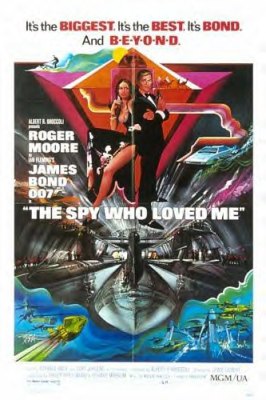
THE SPY WHO LOVED ME
1977 / 126 minutes
Starring: Roger Moore, Barbara Bach, Curt Jurgens, Richard Kiel, Caroline Munro
Director: Lewis Gilbert
Screenplay: Richard Maibaum, Christopher Wood
Cinematographer: Claude Renoir
Music: Marvin Hamlisch
Editor: John Glen
Art Direction: Ken Adam
Theme Song: Carly Simon
Producer: Albert Broccoli
Unaware that he has killed Russian agent Triple X's (Barbara Bach) lover, James Bond (Roger Moore) returns to England when a British nuclear submarine is reported missing. As well, someone has contacted the British government, offering to sell a sophisticated submarine tracking device to the highest bidder. At first competing with Major Amasova (Triple X) to find the plans for the submarine tracker, Bond teams up with Amasova (because their governments make them) to trace the seller's connections back to Karl Stromberg, a fantastically wealthy shipping tycoon and recluse, who lives in a fabulous underwater hideout. After various complications, including Stromberg's henchman trying to kill Bond (he escapes with his Lotus submarine) and Amasova being kidnapped, Bond is captured by Stromberg's submarine-eating oil tanker, the Liparus. Once inside the tanker, Bond must battle Stromberg's henchman and foil his plans to start World War Three by nuking New York City and Moscow. Bond must also rescue Amasova from Stromberg's hideout.
The Spy Who Loved Me certainly exceeded Broccoli's hopes at the box office; it pulled in over twice what the last Bond film grossed, and became the biggest Bond film to date in ticket sales. The critics ate it up, too, saying it was a return to the glories of the early Connery Bonds, and a welcome relief from the previous dour Moore Bonds. Its success firmly reestablished Bond as a viable, on-going film franchise, and cemented the image of Roger Moore as James Bond for a whole new group of moviegoers.
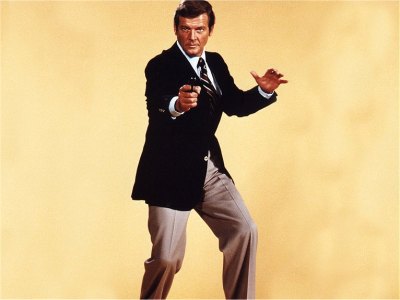
It's easy to see why 1977 audiences loved the movie. It's pure fantasy, with even the slightest sense of realism taking a vacation. The special effects are appropriately outsized and designed to awe the spectator (Stromberg's hideout rising from the sea was a big crowd pleaser, as I remember). But what probably grabbed audiences - particularly family audiences - was the silly, jokey tone of the entire film. Director Lewis Gilbert, who had previously helmed the Bond film, You Only Live Twice, was brought in to liven up the proceedings, to give the film an air of spoofy fantasy that Broccoli sensed was the only way to keep the franchise going. Reportedly, Gilbert and Moore shared exactly the same kind of humor, so the film takes a sharp left where the comedy is concerned. That's tough to do considering how jokey the previous Bonds already were, but somehow they step the comedy up a notch. Certainly the inclusion of the cartoonish henchman Jaws (Richard Kiel), who kills his victims by chomping on their necks with his metal teeth, set the tone for the film. Nothing seems to kill Jaws, including falling through a roof, having his teeth electrocuted, or having several hundred tons of stones fall on him. He's able to tear apart a car like a tuna can, as well as lifting it up like a toy. Audiences loved this character, but he's symptomatic of the silliness that would follow in the series. Gilbert and the screenwriters can't leave well enough alone. When Bond and Amasova escape from Jaws' clutches in a beat-up van that he's destroyed, the music cue they use, as they roll across the desert, sounds like a Disney cartoon. And to top it, when the van dies, and Bond looks at Amasova, the soundtrack cues up a "dink!" when he smiles. The movie is rife with such cutesy moments, from silly Lawrence of Arabia music cues, to Jaws' various outlandish antics, including biting a shark to death. One cannot see Connery putting up with this kind of nonsense.
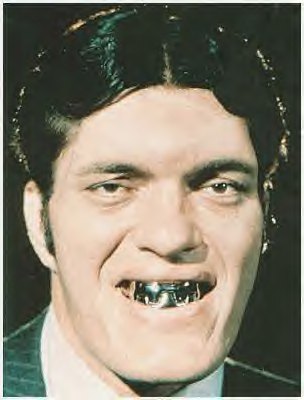
The acting doesn't help much either. I always suspected that Jaws became such a hugely popular character because everyone else in The Spy Who Loved Me delivers their lines in a stupor. It's distressing to see Moore already tired around the eyes, clearly walking through his role. He had some tough scenes in The Man with the Golden Gun that approximated the Connery touch, but evidently, that's precisely what director Gilbert thought was wrong with the previous Moore Bonds, so he takes the bite out of the character. Moore has little to do but to show up and look good doing it. Bach looks good as well, but she's hopeless as an actress. Her blank stare and strangely immobile mouth suggests not smoldering sexuality, but recovery from oral surgery. As for Jurgens, he's clearly embarrassed by what he has to do here (they put webs on his hands, for God's sake - which, by the way, they don't make much of in the film). Originally, his character was to be Bond's arch nemesis, Blofeld, but a lawsuit with perennial thorn-in-the-side Kevin McClory precluded that. So...the screenwriters still write the character as Blofeld, and just change his name. There's not much menace to his plot, which we've seen before. The script is filled with terrible double entendres ("Tell him to pull out immediately!") and lazy plotting. The middle section drags badly, and the final battle is noisy and unconvincing, despite the detail of the huge tanker set built at the then-new 007 Soundstage at Pinewood Studios.
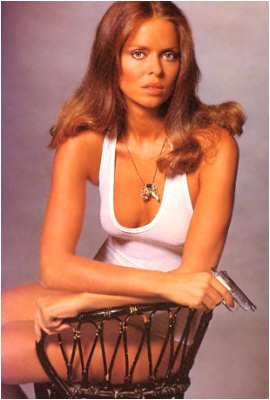
The DVD:
The Video:
As I stated in the Thunderball section, the Lowry restoration is miraculous. Famed cinematographer Claude Renoir shot The Spy Who Loved Me, and his subtle, gorgeous color cinematography is back here finally, in this DVD. Much of the various color shadings that Renoir achieved were lost in previous transfers, so it's marvelous to see them back. It's a pristine image.The Audio:
There's terrific separation in the DTS Surround/5.1 Dolby Surround soundtracks for The Spy Who Loved Me, particularly during the loud, long submarine attack sequence. Careful with your speakers.The Extras:
As with all the James Bond Ultimate Edition: Volume 2 discs, there's a boatload of extras for The Spy Who Loved Me. There are two full-length audio commentaries on disc one. The first is a special treat: a newly recorded commentary with Sir Roger Moore. As he says at the beginning, it's a one-sided conversation, because you the viewer can't ask any questions, and he'd just lie anyway in response to what you'd ask him. The entire commentary is as entertaining and easy-going as Moore was in his films. It's really very funny and quite informative. Next, there's a previously released commentary with director Lewis Gilbert, production designer Ken Adam, and the screenwriters Michael G. Wilson and Christopher Wood. They jump right into the movie, and provide a wealth of insider information on the production. On disc two, the special features are arranged in the same fashion as the rest of the discs. On the Declassified MI6 Vault section menu, there are several documentaries about the production, including 007 in Egypt, narrated by Michael G. Wilson, which contains found 16mm behind-the-scenes footage of the production; Roger Moore: My Word is My Bond, again narrated by Wilson, that shows clips of a vintage interview with Roger Moore on the massive tanker set; On Location with Ken Adam, which includes more home movie footage shot and narrated by the celebrated production designer; 007 Stage Dedication, an original featurette from 1977; and Escape from Atlantis: Storyboard Sequence, narrated by Wilson, showing a vintage storyboard for an altered sequence in the film. The 007 Mission Control section menu is exactly the same as Thunderball's and the others, giving you instant access to your favorite sequences of The Spy Who Loved Me. In the Mission Dossier section, two previously released documentaries are included: Inside The Spy Who Loved Me and Ken Adam: Designing Bond, both from 2000, and both offering important background info on the production. In the Ministry of Propaganda section menu, there are theatrical and television trailers for the film, as well as some radio spots. As well, in the Image Database section menu, there are many stills, with some text information, from the production. There is an eight page booklet, with artwork and additional production information, for each film, included in the box set.Final Thoughts:
They took the guts out of James Bond for The Spy Who Loved Me; Moore was allowed to abandon the overtly macho posturing of his previous Bonds, and indulge in his admittedly pitch-perfect whimsical, fey tone. The theme song (which you couldn't get away from in the late 1970s) perfectly captures the new soft approach to the Bond series, as does Hamlisch's jokey, disco-flavored score. It's been well documented by others how The Spy Who Loved Me is almost an exact copy of director Gilbert's other Bond flick, You Only Live Twice, but the sense of deja vu doesn't help. This clearly was made for international audiences: little dialogue so the translations aren't impacted, and plenty of cartoonish action. In a Bond film, the villain is key. If he doesn't engage us, all is lost. And Jurgens' Stromberg carries little weight. Broccoli and company threw a lot of money on the screen for spectacular stunts (the opening ski parachute scene is indeed memorable, as is the Lotus submarine) and big, shiny new sets, in the hopes of overwhelming the audience. But bigger is not always better, and without a center core of at least some believability, or some respite from the Looney Tunes musical cues that constantly pop up, The Spy Who Loves Me turns out to be a glitzy bore.It's 1985, and where is James Bond going? Roger Moore has been playing the character for over ten years, and ticket sales are lower for each subsequent film. Clearly, Moore and the character need to part ways. It's a pity that Broccoli didn't end Moore's association with Bond at Octopussy, the fairy-tale like fantasy that pleased the critics and the public with its fanciful production designs and the carefree tone it achieved. However, Moore would have one more Bond up his sleeve, and it would prove to be the worst of all the Bond films.

A VIEW TO A KILL
1985 / 131 minutes
Starring: Roger Moore, Tanya Roberts, Christopher Walken, Grace Jones, Patrick Macnee
Director: John Glen
Screenplay: Richard Maibaum, Michael G. Wilson
Cinematographer: Alan Hume
Music: John Barry
Editor: Peter Davies
Production Designer: Peter Lamont
Theme Song: Duran Duran
Producer: Albert Broccoli
After recovering a vital microchip that's impervious to electromagnetic pulses, and thwarting Soviet troops in Siberia, James Bond (Roger Moore) returns to England, only to find out that the stolen microchip is an exact replica of a chip made by Zorin Industries, headed by French industrialist, Max Zorin (Christopher Walken). With the entire crew in tow, including M, Moneypenny, and Sir Godfrey Tibbett (Patrick Macnee), a horse expert, Bond goes to Ascot to scope out Max Zorin (why in the world would M ever be seen in public with James, let alone Moneypenny?). While there, Zorin's horse pulls off a miraculous win, which Tibbett and Bond immediately think is suspicious. Put on the track of a French detective who might have information concerning the funny business going on with Zorin's horse, Bond arrives in Paris. Meeting the detective at the top of the Eiffel Tower, he is unfortunately killed by Zorin henchman, May Day (Grace Jones), before he can disclose the needed information. May Day leaps to her escape from the Tower, and Bond follows in a madcap car chase.
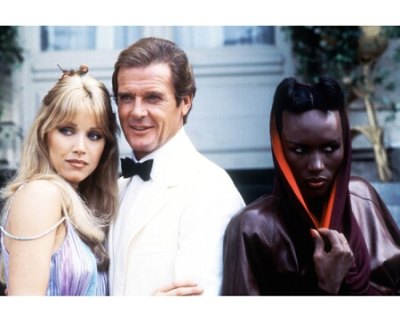
Posing as a nobleman, with Tibbett in tow as his servant, Bond goes to Zorin's French estate for the purpose of buying one of his horses. There, he finds out that Zorin was able to implant a microchip in the horse to give a delayed injection of hormones. But Bond is found out, and Tibbett is killed. It's revealed that Zorin is not only an agent of the KGB, but he is also the product of a Nazi concentration camp experiment, producing a superior intelligence, but also a psychopathic personality. This becomes evident when Zorin reveals his plan to flood the San Andreas Fault with seawater, and collapse it, flooding Silicon Valley, and cornering the market on microchips. Can geologist Stacey Sutton (Tanya Roberts) help Bond stop Zorin's evil plan?
There's really not much that can be said in defense of A View to a Kill. It's not terribly difficult to pin down what's wrong with it: it's tired. Everything about it has been done before, and better. First, it's fatally overlong. At 131 minutes, a good half hour at least could have been chopped out of the film, only helping it. The film starts off poorly with a ski sequence that we've seen too many times already in a Bond film. The director and screenwriters don't help when they insist on a ridiculous inclusion of Bond snowboarding down the mountain to the strains of The Beach Boys' California Girls. If you're going to make a spectacle of your treasured character, could you at least pay the money for the real recording of the song, instead of using a knock-off cover band? That's the whole problem with A View to a Kill - it's phony. When Bond rides off with another girl at least half his age (Moore truly looks too old to playing these kind of adolescent games) in an iceberg submarine, the audience I saw this with groaned in dismay. The only time the audience perked up was the theme song that followed; Duran Duran was huge in 1985, and most of the kids on opening night seemed to be there for the song only. It's a great Bond theme - but it only lasts a few minutes.
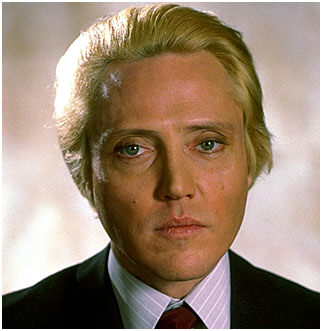
For the duration of the film, we're stuck with a horribly long set up with all the horse shenanigans that absolutely deadens the film. There's a steeple chase sequence that seems to bode well for the film, but it's ruined by obvious trick shots of Walken and Moore on fake horses. The middle section, taking place in San Francisco, is equally dull, with an unconvincing fire sequence at the City Hall, and a totally pointless fight with Bond and a series of intruders at Roberts' house. There's a car chase involving a fire truck that has its moments, but there are entirely too many process shots of Moore, obviously hanging in there in front of a blue screen. The final two action sequence - the destruction of the Zorin Mine and the Zorin blimp fight - are well handled, but honestly, after sitting through almost an hour and a half of tedium, it's hard to get excited about them. Roger Moore looks perpetually startled in this film; I remember seeing the film on the big screen, and people were openly laughing at him whenever there were close ups of his strange new set of eyes. Personally, I hope I look that good at 58, but clearly, Moore is too old to be playing the part with any conviction, particularly when they team him up with such younger women. There was much excitement in 1984 for Bond fans when Walken was named to be the next Bond villain; a lot of people thought he'd bring some real acting chops to the role. But alas, it was all for naught. Walken isn't given much to do, and he comes off badly as the grinning, giggling Nazi psychotic super-intellect. Grace Jones' May Day is an interesting henchmen that really could have been something in another Bond film, but here, she's wasted, too, with an all-too abrupt conversion to the side of Right and Virtue that's never adequately explained. The less said about Tanya Roberts, the better.
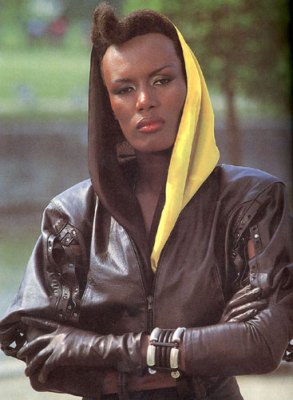
The DVD:
The Video:
I remember being particularly impressed with the way A View to a Kill looked on the big screen, especially during the second half of the film with the night shots in San Francisco, the mine sequence, and the blimp fight atop the Golden Gate Bridge. All of that has been faithfully rescued in the Lowry restoration. Earlier video transfers were particularly harsh with the color balance of A View to a Kill, but everything appears correct here.The Audio:
The DTS Surround/5.1 Dolby Surround audio tracks for A View to a Kill capture the Duran Duran theme song sensationally - it's a kick ass theme, and feeling it vibrate the glass in your windows is the only way to do it.The Extras:
As with the other discs in this collection, there are an incredible number of extras included here; they're set up the same way on all of the discs. On disc one, there are two audio commentaries that can be run with the film. The first features another new "discussion" (he refuses to call it a commentary track) with Sir Roger Moore, where his freewheeling comments include not just this production, but his entire career. It's another fun two hours with a great storyteller. The second commentary is narrated by television producer David Naylor, featuring additional commentary by director John Glen, producer Michael G. Wilson, actor Patrick Macnee, and other cast and crew members.On disc two, there are several interesting documentaries in the Declassified MI6 Vault, including Film '85 BBC Report, a vintage featurette from 1985 featuring interview with the cast; the Original Promotional Featurette from 1985; The Streets of San Francisco: Deleted Footage that highlights alternate footage of the great firetruck chase; Float Like a Butterfly: Test Footage, which shows test footage of they worked out the "butterfly kill" at the Eiffel Tower restaurant; Deleted Scenes with Introductions by Director John Glen, which include footage from The Paris Police Station, Stacey Gets Fired, Protesting Zorin, and Zorin and Crew Pull Up to City Hall; and finally, Alternate and Expanded Angles, with Introduction by director John Glen, which highlight never-before-seen footage and alternate angles to recreate The Eiffel Tower, The Drawbridge, and Bond Rescues Stacey sequences. The 007 Mission Control section menu is set up exactly the same as the others, allowing you instant access to your favorite scenes in A View to a Kill. In the Mission Dossier, there are two previously released documentaries: Inside A View to a Kill and The Bond Sound: The Music of James Bond, both from 2000. As well, the Duran Duran theme song music video from 1985 is included. In the Ministry of Propaganda section menu, there are vintage theatrical and television trailers (by now, the studios had largely abandoned radio spots). And in the Image Database section menu, there are the usual wide array of stills, and some text info, of the stars and the production. There is an eight page booklet, with artwork and additional production information, for each film, included in the box set.
Final Thoughts:
A View to a Kill is not the way Roger Moore should have went out on the Bond series. It's a tired exercise in recycled Bondian motifs that does a real disservice to the audience -- and to Moore. For over a decade, Roger Moore was James Bond to the entire world, and deserved better than this as his swan song. Yes, there's some humor in seeing Christopher Walken say (in a perfect Christopher Walken imitation), "More! More power!" when his blimp is tied up on the Golden Gate Bridge, but it's small comfort for the tedium that proceeded it. The main conflict of the story -- the flooding of Silicon Valley to corner the market on microchips -- just doesn't get the audience fired up the way it should, and the film suffers for it. A View to a Kill is the very worst of the Bond series.In 1989, Albert Broccoli had a problem. His new, much heralded James Bond, Timothy Dalton, was too good an actor for the character he played. What other reason could there be for the relatively ho-hum reaction to Dalton's first outing as Bond, the superior The Living Daylights? That film was in the classic mold of the James Bond film, harking back to the Connery era, striking a tone similar to From Russia with Love. But the public wasn't that enthusiastic. Was it because they needed time to get used to Dalton? Was it because Dalton was too intense as Bond? Or was it because the Bond character needed an overhaul, bringing him more into line with the coming dangerous '90s, and less involved with the too-familiar East vs. West Bondian conflicts?
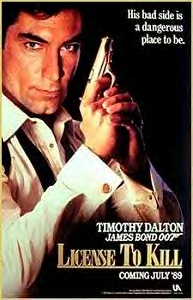
LICENCE TO KILL
1989 / 133 minutes
Starring: Timothy Dalton, Carey Lowell, Robert Davi, Talisa Soto, Anthony Zerbe
Director: John Glen
Screenplay: Richard Maibaum, Michael G. Wilson
Cinematographer: Alec Mills
Music: Michael Kamen
Editor: John Grover
Production Designer: Peter Lamont
Theme Song: Gladys Knight
Producer: Albert Broccoli
On the way to CIA agent Felix Leiter's (David Hedison) wedding, James Bond (Timothy Dalton) comes along with Felix when word comes down that notorious drug lord Franz Sanchez (Robert Davi) is in nearby Cray Key, Florida. Sanchez has caught his mistress, Lupe (Talisa Soto) in bed with another man; he promptly orders the man's heart cut out, as he sadistically whips Lupe's back. Bond and Leiter capture Sanchez, and parachute back to the wedding.
However, Bond and Leiter don't count on the power of Sanchez' money to buy his freedom. Sanchez has bought off DEA agent Killifer (Everett McGill), who helps spring him from federal custody. Sanchez sends his henchman, Dario (Benicio Del Toro) to kill Felix's wife, and bring Felix to Sanchez. Sanchez strings up Felix, and feeds him to a hungry shark, which bites off Felix's leg. When Bond discovers the couple at their home, he immediately sets out for revenge against Sanchez by first killing Killifer. M flies down to Key West, to bring Bond back to his duties, but Bond refuses. He's stripped of his licence to kill by M, but before he can be taken into custody, he escapes, effectively becoming a rogue agent. With money taken off one of Sanchez's associates, Bond travels down to the Republic of Isthmus, where Sanchez controls the corrupt government. With the aid of feisty CIA agent and pilot Pam Bouvier (Carey Lowell), Bond discovers that Sanchez has devised a way to conceal cocaine in gasoline tankers, for shipment to drug lords across the world. Can Bond and Bouvier stop Sanchez's deadly drug ring?
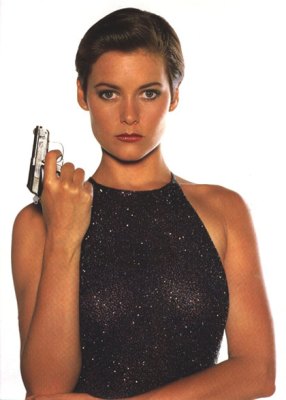
There's a lot going on in Licence to Kill for Bond fans; it's one of the best titles to discuss with fellow fans because there's so many intriguing elements to it, both in front and behind the cameras. Perhaps most interesting in Licence to Kill is the deviation from the so-called "family friendly" maxim that used to rule the Bond franchise. Sure, there was sex and violence in the previous Bond films, but Broccoli and Saltzman always made sure that it was discreet enough to keep families coming back (although I would question the tameness of that snow blower grinding up a skier in On Her Majesty's Secret Service, shooting out great gouts of red snow). Licence to Kill is without a doubt the nastiest, meanest Bond to come along in the series (although I hear the new Casino Royale outstrips this film in the violence department). The movie starts right off in new territory, showing a woman getting viciously whipped, while off camera, the audience understands that a man is getting his heart cut out. Later, Felix Leiter, a beloved character in the Bond canon, gets his leg gnawed off by a shark (straight from the Fleming novel, Live and Let Die), and his wife is brutally murdered (and possibly raped). Later, a key character is shown impaled on a forklift, while most notoriously, Krest (Anthony Zerbe) is shown, in full close-up, having his head explode in a pressure chamber, and Dario is shown falling into a grinder, while the camera shows chunks of his body coming out the other end. While these scenes are nothing new in regular action fare, they were a cold slap in the face for regular Bond viewers who were used to the more subtle, humorous forms of Bondian mayhem. Not surprisingly, Licence to Kill received the first PG-13 rating ever for a Bond film. This may have contributed to the film's decidedly cool reception at the box office.
There's nothing humorous about the violence, either - nor in Dalton's performance, for that matter, and that may explain as well why people were non-plussed by Dalton's appearances. Dalton, a highly respected actor prior to taking on Bond, made it clear that he wanted to go back to the novels for his character's inspiration. Dalton is dead serious in his thesping, and that's quite a bit different from Moore's interpretation (and Connery, as well). There's something missing from Dalton's Bond; it's difficult to describe, but put simply, he just doesn't have the "star quality," the larger-than-life stature needed to wear the Bond tux. He's too confined in his interpretation, too screwed-down, to make the character accessible to the audience. Physically, he's wrong for the part, too. He doesn't fill the frame the way Bond should. Connery, Lazenby, and Moore were physically large men; they commanded attention the minute they strode across the screen. Dalton doesn't. He's a great actor - certainly the best actor to attempt Bond - but he's the wrong type.
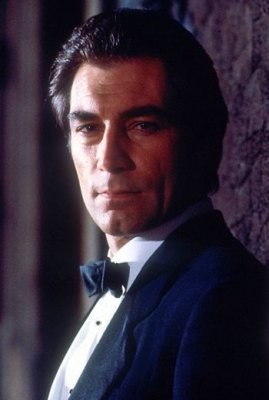
And if Dalton can't make Bond his own, then the seismic earthquake that should accompany Bond not only quitting Her Majesty's Secret Service, but also becoming a rogue agent, never appears. This is a serious breach of the Bondian mythology, and it doesn't register a blip on the screen, mostly because the audience never embraced Dalton as Bond. If Connery or Moore had quit, the audience would have felt it. And while the action is cool and tough and nasty in Licence to Kill, there's nothing remotely "Bondian" about the film. It could very well be an excellent episode of Miami Vice; Dalton can't make Bond his own, and Licence to Kill just becomes an anonymous, gritty actioner. There's much to like in Licence to Kill; as I said, the action is first rate, with a spectacular (if somewhat familiar) truck chase sequence at the end of the film that's smashing. But that sequence is indicative of what's wrong with Licence to Kill; how is the world in peril with Bond hanging off the end of a truck in Latin America? There's no huge sweep to the film, no gigantic world threat that must be dealt with - it's only a grubby little drug dealer. We need Bond to dispatch that kind of villain?
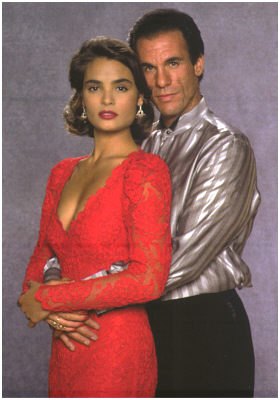
The DVD:
The Video:
Licence to Kill looked terrific on the big screen, with a hard-edged color scheme, and a shimmering, luminescent finale on the dusty back roads of Mexico. So I was anxious to see how it looked in the Lowry restoration. It looks, in a word, remarkable. There are no specs or scratches in the print, and the color balance is exactly the way I remember it in the theatre. Blacks are absolute (there are many night scenes), and the transfer is flawless.The Audio:
The DTS Surround/5.1 Dolby Surround audio tracks for this Licence to Kill blow the doors off the old DVD copy I have; these are astounding mixes which create incredible separation during the action sequences. They really have to be heard to be believed.The Extras:
The James Bond Ultimate Editions contain a treasure trove of supplemental material, particularly for Licence to Kill. On disc one, there are two full-length commentary tracks. The first is hosted by John Cork, and features comments by director John Glen, actress Carey Lowell, actors Robert Davi, David Hedison, Benicio Del Toro, and Desmond Llewelyn. It's a lively look at the film, with great background on this tough Bond flick. On the second commentary, Cork again moderates, and we hear from a whole slew of crew members, including Michael Wilson, cinematographer Alec Mills, production designer Peter Lamont, visual effects supervisor John Richardson, special effects supervisor Chris Corbould, with many other crew members.
In the Declassified MI6 Vault there are a ton of new, never released supplements that really make this disc. Included are Deleted Scenes with Introductions by Director John Glen, including the scenes: Sharkey Arrives, Bond and Sharkey Follow Yacht, Bond in Hotel Room, Cash Transaction, Bond in Isthmus, "Bienvenidos Mis Amigos," Bond Returns to Casino, Bond Captured by Hong Kong Narcotics Agents, and Boat Ride. Bond '89 follows, with vintage interview with the cast and crew on location. On Set with John Glen is hosted by the director, talking about the various production aspects of Licence to Kill. On Location with Peter Lamont is narrated by Lamont, showing vintage scouting location footage for the film. And Ground Check with Corky Fornoff is vintage video footage of the aerial coordinator discussing the various challenges of the aerial footage. The 007 Mission Control section menu is the same as the other discs, with instant access to your favorite moments in the film. The Mission Dossier section menu contains several documentaries, including Inside Licence to Kill: A Documentary from 1999, which features several members of the cast and crew reminiscing about the production; an original Production Featurette from 1989, showing behind-the-scenes footage of the production; an undated (but it appears vintage from 1989) Kenworth Truck Stunt Film, that discusses all that went into the spectacular truck stunts; and finally two vintage music videos for Gladys Knight's theme song, and Patti Labelle's end credits song. In the Ministry of Propaganda section menu, two theatrical trailers are included (no television ones are here). And in the Image Database section menu, there are stills and text information on the production, including some of the Bob Peak advertising that was commissioned for the film, but then abandoned when the film underwent its title change. There is an eight page booklet, with artwork and additional production information, for each film, included in the box set.
Final Thoughts:
Licence to Kill is a real anomaly in the Bond pantheon; it's nasty and vicious, and seems to point the way for more violence in the coming Bond films. But it lacks the scope and world threat that are so key to a true Bondian film experience. The acting is first rate, but excellent acting doesn't substitute for star quality, and Dalton never wears the Bond image. Worthwhile, but ultimately, not a Bond film.Fast forward all the way to 2002. Timothy Dalton's second and final appearance as James Bond in Licence to Kill is hailed by the critics, but proves to be one of the least successful Bonds at the box office. Still, a new Bond film starring Dalton is planned for 1991, but legal problems postpone the start of production until 1994. By then, the official story is that Dalton has had enough, waiting around for Bond, and exercises an option in his contract to leave the series (others say after the desultory performance of his two previous Bonds, he was quietly let go). Now, the search is underway to find a new Bond, and Pierce Brosnan, who was in the running for Bond back when Dalton got it, now steps into the role without mussing one hair on his head. His initial foray into the Bond canon is GoldenEye, which was an excellent Bond film that only suffered from Brosnan's presence. But the film made a pile of dough (probably because James Bond had been off the screen for almost six years), and Brosnan held onto the role like grim death. Despite claiming each and every Bond film was his last (in an effort, one must assume, to sound like Connery), Brosnan would go on to make three more Bonds. In what would prove to be his last appearance as James Bond (thank God), Pierce Brosnan pulls out all the stops in Die Another Day, and sets his jaw four different ways while squinting his eyes two different ways, proving that he's far from being a one-note actor.
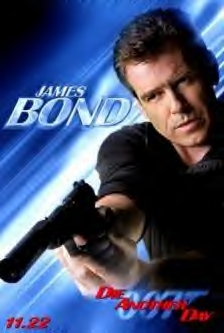
DIE ANOTHER DAY
1989 / 133 minutes
Starring: Pierce Brosnan, Halle Berry, Toby Stephens, Rosamund Pike, Rick Yune, Judi Dench. Oh yeah, and Madonna.
Director: Lee Tamahori
Screenplay: Neal Purvis, Robert Wade
Cinematographer: David Tattersall
Music: David Arnold
Editor: Andrew MacRitchie, Christian Wagner
Production Designer: Peter Lamont
Theme Song: Madonna
Producer: Barbara Broccoli, Michael G. Wilson
Evidently, James Bond (Pierce Brosnan) didn't think that someone could place his face when he infiltrated Colonel Moon's (Will Yun Lee) weapons-for-conflict diamonds smuggling ring. The North Korean Colonel isn't happy with a British assassin sent to kill him, so he tries to kill the fleeing Bond. But Bond manages to cause Moon's death (or did he?), for which he is imprisoned for 14 months of intensive torture. When Bond is traded for the Colonel's brother Zao (Rick Yune), Bond immediately cuts his hair, gets a shave, and goes back to North Korea to find out who originally ratted him out to the Koreans. Eventually, he hooks up with Jinx (Halle Berry), a NSA agent in tracking Gustav Graves, a mysterious British adventurer who has invented Icarus, a space-based mirror that will concentrate the rays of the sun...to grow things for people. Of course, Graves has other plans for Icarus, and it's up to Bond and Jinx to thwart his evil plans.
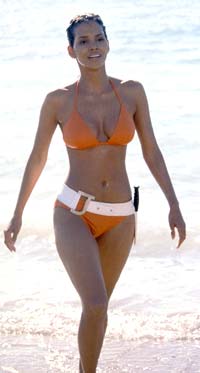
What can one say about Pierce Brosnan as James Bond? Considering his films made a boatload of money, I can only assume that there's a sizeable number of people out there who think of him as their James Bond. Well, you can have him. I remember when Brosnan first appeared as James Bond; film critic Gene Siskel said he thought Brosnan was physically a lightweight, and therefore not believable as Bond. That statement caused a lot of bad press for Siskel (Brosnan had a lot of defenders, evidently), but essentially, Siskel was right. In fact, he didn't go far enough. Not only is Brosnan physically unprepossessing as Bond, he's not remotely actor enough to essay the role competently. This is James Bond as Runway Model, not as a super-tough agent who all women want. There was a further softening of the character when Brosnan took the role, that went all the way back to Moore's more silly interpretation. When Dalton took over, there were public concerns about Bond's many sexual conquests in the age of AIDS, and if you can believe it, the producers took those concerns seriously. With Brosnan taking over, it was felt that a further feminization of the series was needed, so Bond's boss was now a woman. And not just any woman, but England's Dame Judi Dench. In their first encounter on the screen, she upbraids him as a sexist, misogynist dinosaur - and he took it! Can you see Connery or Lazenby doing that? Call me insensitive, call me a dinosaur, but keep your politically correct hands off the Bond character. Get sensitive with some other franchise. The Bond character was essentially neutered in the Brosnan era, and the producers couldn't have asked for a more narcissistic, shallow, frail embodiment of that new vision, than Brosnan.
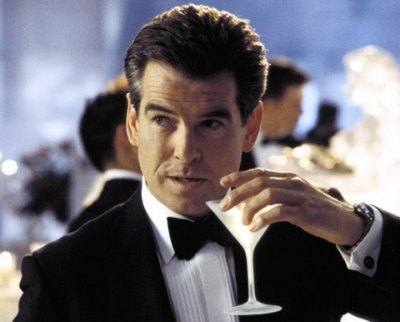
As for the film, it's a ridiculous mixture of laughable CGI special effects (check out Brosnan on his parachute surf board, or the flaming Icarus airplane at the end of the film), and one internally dead scene after another. It's rare to see so many individual scenes strung together without the simplest concept of rhythm or dramatic drive. I'm a big fan of Tamahori's earlier adventure flick, The Edge, but it's hard to connect that director with this ungodly mess. Particularly disturbing is the "black box" feel of most of the film. Largely created out of CGI wholecloth, the film has a claustrophobic feel that's the antithesis of how a Bond film should look and feel. As well, the plot's obvious borrowing from other Bond films, particularly Diamonds Are Forever, give the film a bad case of deja vu. As well, the numerous howlers in the script eliminate any chance the film has at gaining our sympathy. The screenwriters, in an obvious bid to appeal to the international market, slant the film with so many anti-West, anti-American slams that it got to the point where I was wondering why the hell I was watching this junk. The most grievous example of this was the CIA agent, Damian Falco (Michael Madsen), a repulsively simplistic, cliched example of the worst kind of American-as-dope character that international audiences love to hate. Other examples include hearing a North Korean General say the West corrupted his son (North Korea being the paradise it is, I can understand that), and that Cuba has the best health care system in the world. Eventually, the viewer must ask: is this a Bond film, or an anti-American poly-sci course at Yale? Oh yeah, and Madonna's in it. Case closed.
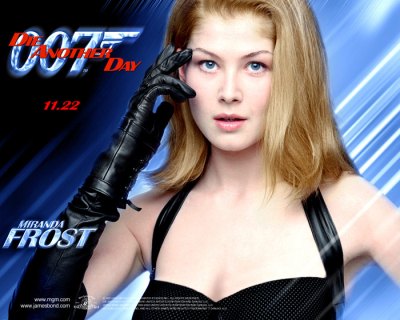
The DVD:
The Video:
When I saw Die Another Day in the theatres, it looked icy cold blue. That look is still evident here, so I can only assume that the Lowry restoration was successful. I can't imagine there was much, if any, deterioration in the original source materials, but the comprehensive transfer accurately recreates the look of the original projected image.The Audio:
The DTS Surround/5.1 Dolby Surround audio tracks for Die Another Day is vibrant, with excellent separation effects. Unfortunately, the worst theme song of the entire Bond canon, sung by none other than Madonna, comes through loud and clear.The Extras:
As with all the discs in the James Bond Ultimate Editions box sets, Die Another Day has a lot of extra material waiting for you. On disc one, there are two commentary tracks to go along with the movie. The first commentary track features Brosnan and co-star Rosamund Pike. The second track features producer Michael G. Wilson and the director Lee Tamahori. It's a fairly informative track. There's also an interactive feature, the MI6 Datastream which can be activated prior to the movie starting, that give you supplemental interviews and production information during the course of the film.
The second disc contains the Declassified MI6 Vault section menu. Here you'll find all new documentaries, including: From Script to Screen, which details the process of writing and producing a Bond flick; Shaken and Stirred on Ice, which illustrates the challenges of shooting on location in Iceland; Just Another Day, which chronicles the effort involved in getting just one sequence done on location; The British Touch: Bond Arrives in London is a short segment on how they shot the sequence where Bond rides home to England; and finally On Location with Peter Lamont, a look at how the production designer scouts locations. As well, there's the 007 Mission Control section menu that features the same menus as the previous discs, letting you jump immediately to your favorite sequences in the film. The Image Database section menu provides stills and information on the production of the film. One note on the special features for Die Another Day; listed on the back of the slim case, in the liner notes, they indicate that a Ministry of Propaganda section menu should be included on the disc, featuring trailers, TV spots, and radio clips. This menu is not on either disc. It doesn't appear on any main menu, and I searched around for awhile, trying to see if it might be hidden as an Easter egg. But since the other discs have that particular menu, with the trailers, I see no reason why the would hide it here. I can only assume the liner notes are a misprint. If anyone else receives this disc with that particular supplement on it, please email me and let me know. There is an eight page booklet, with artwork and additional production information, for each film, included in the box set.
Final Thoughts:
Die Another Day is high-tech, glossy junk -- no ifs, ands, or buts. Brosnan was a weak, ineffectual pretty-boy Bond who devalued the Bondian myth, and his petulant reign as 007 has thankfully come to an end. Evidently, the producers of Bond got the message; all reports for the new Bond film, Casino Royale, emphasis how the film returns to the tough, gritty, violent world of espionage created in the Fleming books and Connery films. Die Another Day is to be avoided at all costs.The James Bond Ultimate Edition: Volume 2 box set would at first seem like an expensive, iffy choice for the average Bond fan -- many of whom already own all the films on disc. I certainly felt that way when I first opened the package. However, once I put in Thunderball, and saw the stunning picture clarity, I was immediately hooked. These Lowry restorations are nothing short of miraculous, with the sound quality of the new DTS Surround/Dolby Digital 5.1 Surround tracks equally impressive. Add to that the virtual PhD class in "All Things Bond" that a viewer can achieve by watching and listening to the hours and hours of supplemental extras, and James Bond Ultimate Edition: Volume 2 becomes an absolute must-have for Bond fans. If I had to rate the selection of Bond titles found here in Volume 2, I would hazard to say they're probably the weakest grouping of the four volumes. Two of the films are quite good, one is fair to middling, and two are at the bottom of the Bond barrel. However, the strength of the extras alone, along with the miraculous new image restorations, make James Bond Ultimate Edition: Volume 2 a natural choice for the highest rating we have at DVDTalk: the DVDTalk Collector Series Recommendation.
Paul Mavis is an internationally published film and television historian, a member of the Online Film Critics Society, and the author of The Espionage Filmography.


|
| Popular Reviews |
| Sponsored Links |
|
|
| Sponsored Links |
|
|
| Release List | Reviews | Shop | Newsletter | Forum | DVD Giveaways | Blu-Ray | Advertise |
|
Copyright 2024 DVDTalk.com All Rights Reserved. Legal Info, Privacy Policy, Terms of Use,
Manage Preferences,
Your Privacy Choices | |||||||









